Tom Griffin is the Head of Partnerships at Levels.
It’s no secret that the podcast industry has been exploding over the last decade, with plenty of us tuning into podcasts for news, advice and entertainment — popping in our headphones while washing dishes, walking the dog, or during a commute. It’s estimated that 125 million Americans will listen to podcasts by 2022 — up from 46M in 2015 and 75M in 2018.
Brands are following consumers into the space, figuring out how best to leverage this relatively new platform. Typically, they enter the space as an advertiser — think, “This episode is brought to you by... Blue Apron!” (said in Dax Shepard twang).
But are there ways for brands to leverage this new platform besides throwing advertising dollars at it? What if instead of a 60-second scripted ad read that costs $10,000, you did a 60-minute ad read that deeply educates your target audience on the problem you’re solving, that costs $0? Enter: the Podcast Tour.
A “podcast tour” is when a brand secures podcast interviews for its founders on shows that its target audience is likely listening to. For a startup, the main value of a podcast tour is education and awareness. This is especially true when you’re building a new product category. In the case of Levels, this new category is consumer biosensors focused on metabolic health – starting with continuous glucose monitors.
“Wait, what do you mean by metabolic health? What are glucose monitors? Aren’t those for diabetics? Why would I use one?”
All great questions, best answered through a long-form interview — not a flashy, seven-second Instagram ad or a 30-second podcast ad spot. When the company was started, very few people were talking about “metabolic health,” so we knew that we had a big challenge ahead of us to bring this category into the mainstream. In the early days of building Levels, we needed to find future customers, introduce ourselves and spend as much time with them as possible explaining why we exist and why they should care.
After talking with thousands of people on our waitlist, we learned these individuals were turning to podcasts as one of their primary sources of information and advice on how to improve their health. This was a clear signal to us that in order to reach our target audience, we needed to find and communicate with them through podcasts.
Podcasts are an opportunity to spend an intimate 60 minutes in the ear of thousands of people who have opted in to listen to you alongside a host they trust.
With that in mind, while still in closed beta early on, we embarked on a focused mission that led to our founders appearing on more than 100 podcast interviews in six months (rather than spending thousands of dollars on ad reads or attempting to spin up our own podcast show). Even now, nearly a year later, it’s still paying dividends across nearly every function of our business.
Plenty of folks out there have their eye on podcasts as a marketing tool for promoting a startup’s founders and the product but don’t know where to start. In this article, I’ll share the specific tactics we used at Levels to secure dozens of podcast interviews — from researching all the shows that might fit your audience, crafting your pitch, tapping into your network, nailing the interview, and tracking results. I’ll also include specific email templates and scripts that you can lean on when crafting your own outreach strategy. Let’s dive in.
TESTED TACTICS FOR EXECUTING A PODCAST TOUR
It’s important to emphasize that our marketing goals were primarily education and awareness, and not revenue. If your goal is generating revenue ASAP, you may be better off running ads (more on this later).
In addition to education and general awareness, other benefits of the podcast tour include:
- SEO. Podcast interviews are a great way to get high-quality backlinks for your website at scale, as show notes will almost always include links to your website and social channels.
- Brand building. Podcast tours are one of the fastest ways to build your brand and increase awareness of your company. You’re stepping in front of a pre-built audience who has opted into letting you hang out in their ears for an hour out of their day. Additionally, your brand becomes implicitly validated by the host who has invited you on, who the audience loves, trusts and respects.
- Partnerships and networking. Building relationships with influential podcast hosts can lead to more formal marketing partnerships down the line (including podcast advertising).
- Low cost. To appear on most shows, you don’t need to pay. This means that you can execute this strategy effectively with minimal financial investment.
I’m regularly asked by other brands for tips on how to get their founders on podcasts. Here are the most critical lessons we’ve learned at Levels:
Step 1: Lean on your network to source shows.
With countless shows out there that might be a fit for your startup audience, honing in which ones to prioritize with your outreach is a tall hurdle when kicking off your podcast initiative. There are several simple ways to figure out what podcasts you might target, including:
- 1. Looking at Apple iTunes charts by category, or using tools like Chartable to keep an eye on top and trending podcasts in relevant topic areas.
- 2. Interviewing your customers and prospects to ask them what shows they listen to.
- 3. Hiring a podcast booking agency like Lemonpie and letting them figure it out. Speaking of Lemonpie, I strongly recommend their podcast as a resource for learning more about how to leverage podcasts for your brand (sorry, this is getting really meta).
But our not-so-secret sauce for securing over 100 shows in 6 months was pretty simple: We got really good at leveraging our network. About 60% of all shows we’ve secured over the last 18 months came from our network.
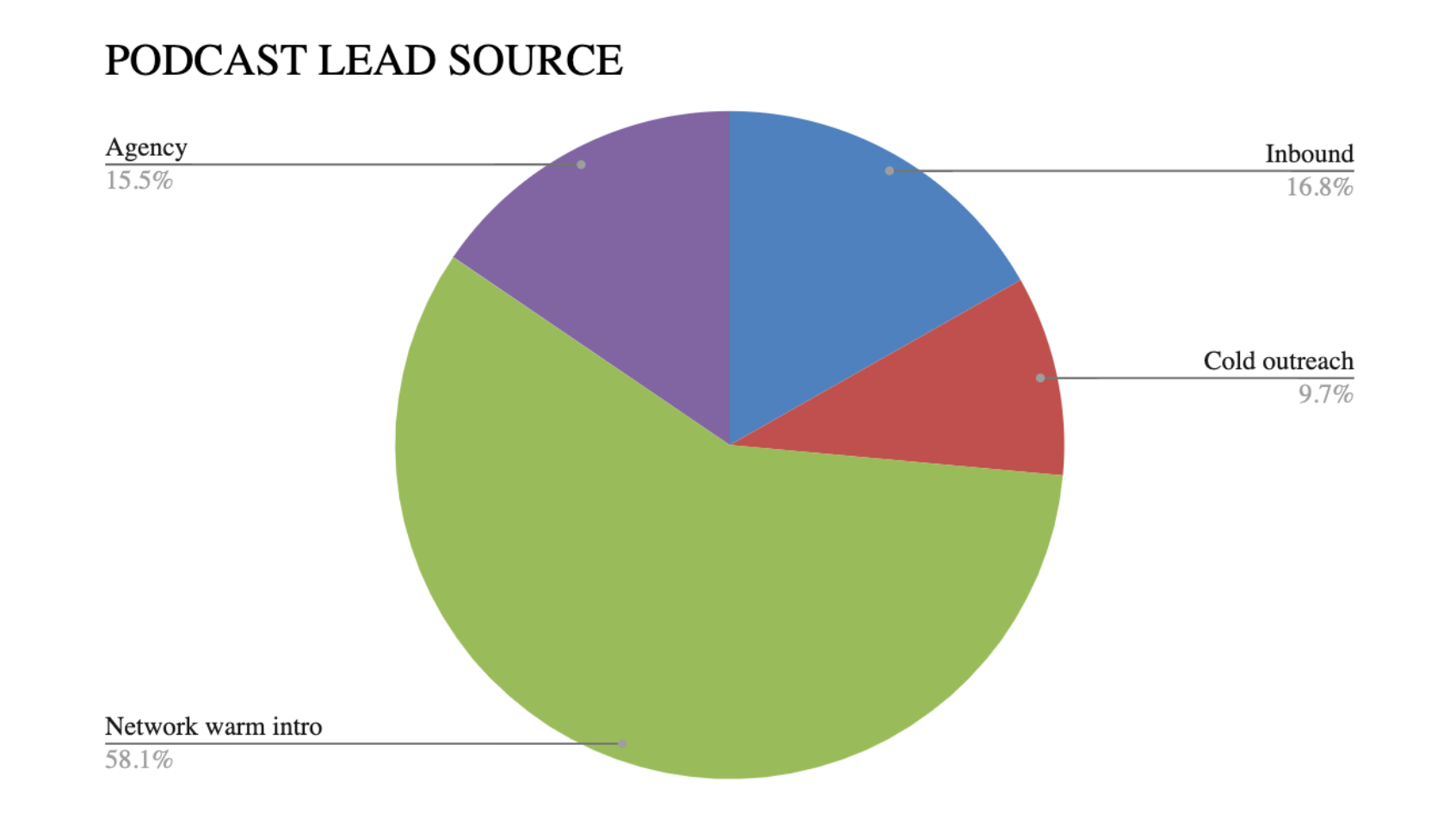
Note on the chart above: Inbound leads only started to come once our founders had been on dozens of shows, including a few very well-known ones.
Let me flag that our company has an unfair advantage here: our investor base alone is over 150 people and they’re quite well-connected, which was an intentional strategy. However, I believe that most of the tactics we used can be applied to any company and founder.
While cold outreach can work, it’s often an inefficient approach. I tried a few rounds and usually saw between 10%-20% response rate. In total, cold outreach was responsive for fewer than 10% of the shows we’ve secured to date. If you do reach out cold, I recommend doing your research and both emailing the podcast (I’ll include some templates), as well as messaging them on LinkedIn. If you’re lucky enough that your founder has a presence on social media, an Instagram DM to the show host can also work.
Ask your investors for help. Then ask your entire network. Then ask them all again.
In addition to formal “investor asks” during our monthly investor update emails, we asked almost everyone we interacted with by phone or email for help connecting us to shows. I don’t say that hyperbolically. We constantly asked for help. One small example: I created a Superhuman snippet that I included in nearly every email exchange, especially those where someone said “Let us know if there’s anything we can do to help!”
Oh, I’m glad you asked :) [types email shortcut] "We're making an effort to get Casey and Josh on more podcasts in Q1 to increase awareness around the problem of metabolic dysfunction in the U.S. and what people can do about it. Do you know anyone who hosts a podcast or who may be able to connect us with someone who does?"
Tip: DO NOT passively say “Let me know if you’re aware of any podcasts we should connect with.” In my experience, you’ll increase your response rate by up to 50% by asking a direct question. Your investors want to help — give them the opportunity to do so in a tangible way.
Do your research. Don’t be lazy.
For instance, at one point I looked up every single one of our investors and advisors on iTunes to find which shows they had been on in the past, then reached out for introductions to relevant ones. By making the ask specific, we saved them the work of having to think of shows that would be a fit — and we probably got 30 bookings from this approach alone. Here’s the email template we used:
“Hi [Name],
We saw you were on [X show] back in November – we’re big fans of [host name] and [X show].
Do you think [host name] would be interested in chatting with Casey or Josh about [tailored sentence or 2 about the topic that would make sense for that show]?
If so, I can follow up in a separate thread with a forwardable email that you can pass along directly to see if they’re interested.”
Make it easy for people to help you with the art of the forwardable email
Step 2: Use other founders as benchmarks.
One of the single most efficient and effective ways to find shows for your founders is to search for founders of similar companies (or spokespeople in similar industries) in podcast databases like Apple. For example, for Levels, I might enter the name for the CEO of Oura into the Apple Podcast App and it will immediately return a list of shows that he’s has been on.
I can then take that list of shows and do a couple of things:
- Reach out to well-connected individuals in our network with the more specific ask of “Do you know the hosts of any of the specific shows listed below, or know anyone who might know them?”
- Reach out to the show cold, but with a much more personalized pitch, now that you know they are interested in a topic relevant to what you’d want to discuss.
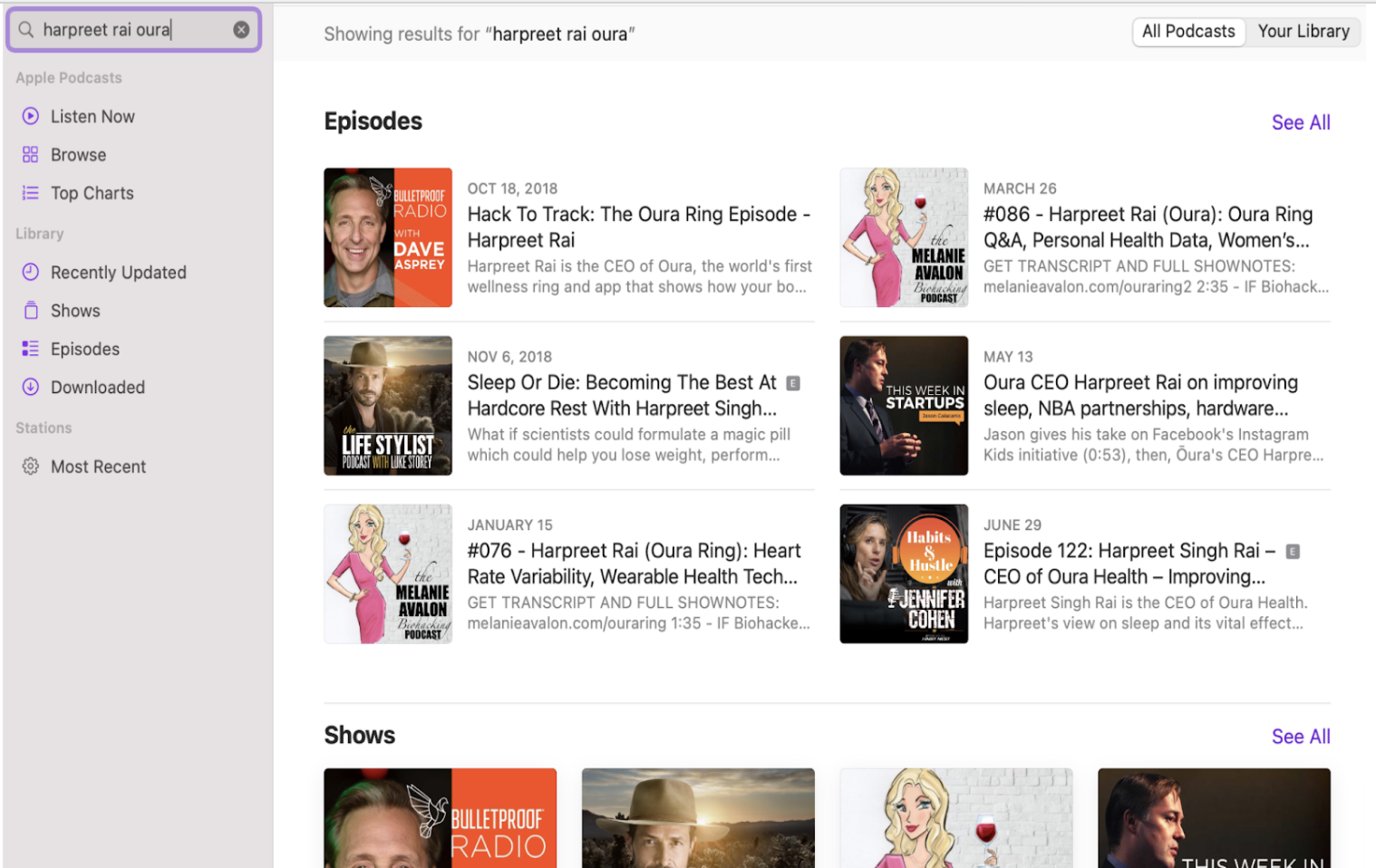
You don’t need fancy tools or internet scrapers that pull 50,000 shows into a spreadsheet. Spend two hours looking at Apple Podcasts by category, as well as searching for founders in your space who have been on shows, and you’ll generate a well-curated list of 100 shows to go after.
Step 3: Don’t pitch your product or your company.
Most of the time, a podcast host doesn’t want to have a guest come on their show to do a one-hour infomercial about a product or service. The host wants to do two things: make their audience happy and grow their audience. Why is someone listening to a podcast? Usually for one of three reasons:
- 1. To figure out how to improve their life (e.g., a podcast about health, psychology, or business tactics).
- 2. To acquire knowledge (e.g., a podcast about current events, history, or science topics).
- 3. To be entertained (e.g., fiction podcast, pop culture, comedy podcast).
For those reasons, here are a few tips for crafting the “pitch” that will be used to convince the host to have you on:
- Think about the listener. When considering what you would discuss on a podcast, always start with the listener.
- Think big. How does my personal story or company mission fit into a much larger storyline? Don’t think at the product or company level, think at the level of industry trends, or better yet societal or civilizational ones.
- Think contrarian. How is your take “new”? What aren’t people talking about enough right now?
Ask yourself: “How can I add practical value to the listener’s life, even if, or especially if, they never buy my product?”

Below are some examples I’ve pulled out of our email pitches. Note: In some blurbs, I mention Levels, in others, I do not. It depends on what topics the podcast typically focuses on and past guests.
For example, some shows rarely have product company founders on, and will tell you that they prefer to have “experts” who are not pushing a brand or product. For these shows, it’s important that you pitch a concept that does not include talking about your company (however, almost inevitably you still will end up talking about your company). For other shows, they regularly have company founders on and love talking about, for example, the process of building a business or, in the case of shows focused on self-improvement, specific tools that their audience can use to improve their lives.
With that in mind, here are a few sample pitches we use, depending on the type of podcast:
The epidemic of metabolic dysfunction in the U.S.: Our goal is to bring awareness to the epidemic levels of metabolic dysfunction in our country and help reverse this trend. Over 120M Americans have prediabetes or diabetes and 7 of the 10 leading causes of death are directly linked to metabolic dysfunction. The majority of this is due to lifestyle factors within our control. In addition to outlining the problem, we can discuss practical tips for improving metabolic health by pulling on lifestyle levers across diet, exercise, stress and sleep.
Personalized nutrition: We can discuss why "What should I eat?" has become a trillion-dollar question. The scale of the problem surrounding this question is staggering – 120M Americans have diabetes or prediabetes, the economic cost of obesity alone in the U.S. is 1.72T per year. 7 of the 10 leading causes of death in the U.S. are directly linked to metabolic dysfunction. One of the key issues: Consumers have no idea what to eat. Dietary advice changes frequently, what works for one person doesn't work for the next, and we've never been able to measure our diet in the way we can currently quantify exercise and sleep. Levels is changing this by bringing to market the first biowearable that provides real-time feedback on how your diet impacts your health.
The keys to behavior change: Present listeners with a new way to think about effective behavior change strategies (see: Levels Theory of Behavior Change), specifically as it relates to health and nutrition habits. Millions of Americans want to make better choices, but it's exceedingly difficult to do so. Our approach at Levels focuses on: 1. Closed-loop systems, 2. Interoception, 3. Accountability and 4. Personal Control.
COVID + Metabolic Health: Dr. Casey Means, Levels co-founder and Chief Medical Officer, will discuss the fight against COVID through a preventative health lens. Metabolic dysfunction — including blood sugar dysregulation and obesity — has been shown to be one of the most significant risk factors for poor outcomes and death from COVID-19, so more people are recognizing that now is the time to improve blood sugar.
Step 4: Track everything and stay organized.
We then used a simple Google Sheet to track every aspect of this process — including podcast name, lead source and which founder would be a guest.
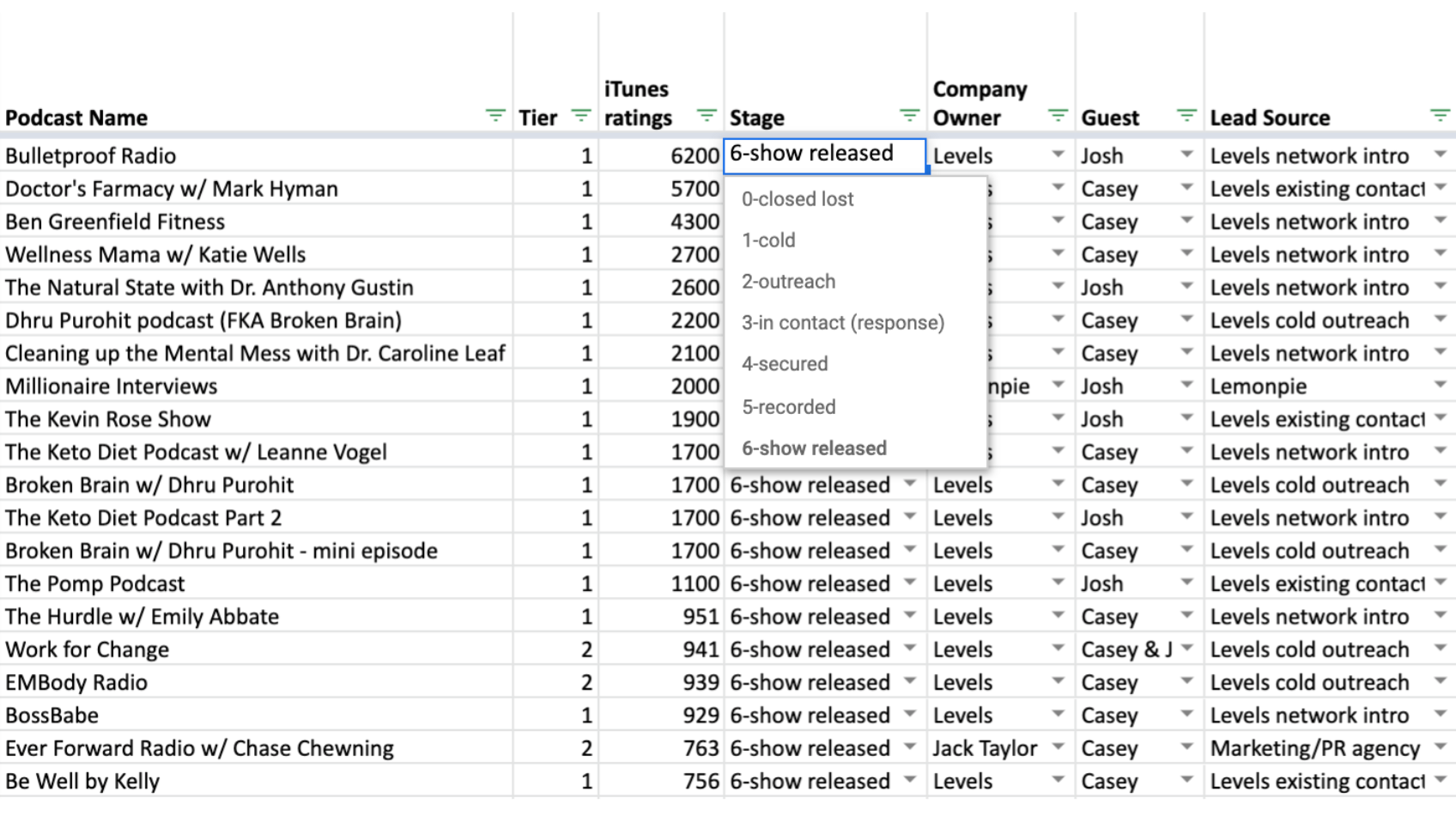
This had all of the typical benefits of staying organized while managing a large pipeline of external contacts, but it also had an additional, unforeseen upside.
- People were impressed by how we were managing the process and, as a result, were more likely to introduce us to people and spread the word about our efforts.
- It allowed us to track metrics over time, including where our leads were coming from in order to help us figure out how we should spend our time.
- At a remote company, clear documentation is key for giving other team members visibility into important company projects, as well as earning the trust of those teammates.
- It allowed us to more easily help people in our network who were also looking to get their founders on podcasts. We were able to send them a clean lead list and they could let us know which shows they wanted to be introduced to.
Step 5: Practice a lot and seek out feedback.
It always surprises people how much practice it takes to refine their long-form interview skills, which is why I recommend trying to book some smaller shows first. The point of your first 15 podcast appearances isn't even awareness or brand-building — it's practice. You have to put in the reps to learn what works and get comfortable. For that reason, you should be almost entirely agnostic as to what shows you do to start (size, subject matter, etc.). A few best practices that have emerged from our time doing podcasts and providing feedback to our founders:
- Add value to the listener’s life. If you do this, the episode will be successful. This is also what motivates a host to have you on their show.
- Nail the opening bio. Have a tight bio where you establish credibility and share relevant personal experience at the start of the interview. Practice this to ensure you’re not speaking for more than a couple of minutes in your opening remarks, usually answering the question “Tell us about your background and what led you to what you’re focused on today.” Do not talk for 15 minutes straight here.
- Remember to tell stories. Have 2-3 personal stories and potentially 2-3 customer stories (if the interview is focusing on your business) handy going into an interview. The goal of any story is to be relatable to the listener and inspire emotion. Usually, this is done by outlining a common pain point and a corresponding emotion (frustration, hope, fear, surprise, etc.).
- Hit your key talking points multiple times throughout the show. It can feel repetitive at times, but it’s important to drive home your main points through repetition.
- Be vulnerable, authentic, and imperfect. Don’t worry if you make mistakes, stumble, or flub a word. Being authentic and imperfect makes you relatable.
- Think contrarian. You should have a shortlist of contrarian ideas that may be surprising to the host or listener. These are good to incorporate into the interview and into your outreach to shows. Some contrarian ideas should make it into every interview.
- Don’t be afraid to pause. It’s critical to be concise in your responses. There is a lot you want to say about your area of expertise and almost any question could warrant a very long response, but you’ll need to condition yourself to pause, even when it feels like you should continue elaborating in order to be comprehensive. The interviewer will ask follow-up questions and you’ll be able to make all your points eventually, I promise.
- Sprinkle in big ideas. It’s worth coming up with a shortlist of “big ideas.” These are helpful in media pitches, podcast interviews, and biz dev calls. The goal is for the listener to zoom out to 30,000 feet and be inspired by a much grander vision than a new product that can help them. When listeners are inspired, they’re more likely to share the episode.
Some podcast guests don’t want to give away their secrets or prescribe too much valuable advice, because they want the listener to go to their website to learn more, buy their product, buy their book, etc. This is a mistake. Give away as much as possible to the listener for free.
Ultimately, the best thing you can do is get feedback on every interview you do, so you can improve. We created a simple document where any team member could drop in notes for our founders on any podcast they had been featured on. This continuous feedback loop really helped them get polished up. A few examples of the early feedback we gave our founders:
- Your tone felt like you were in presentation mode, rather than casual conversation. I think that's going to take some practice, but you should try to frame it in your head as if the person you're talking to is your best friend. The tone was similar to David's initial product walkthrough videos. I asked him to close his eyes and imagine he was explaining it to his wife Stacie, and his tone completely changed (in the right direction).
- I would cut down the SpaceX background that's not related to what you’re focused on today at Levels. It’s fine to do some small talk and humor the host if they’re interested in rocket science, but at some point earlier in the conversation, I think you should try to transition. For example: "And funny enough, SpaceX is actually where I first started getting interested in nutrition, which I know we're going to get into next."
- Talking about your personal experience with fatigue was great, the need for the afternoon coffee, etc. It was very relatable. I think you used to talk about taking a nap under your desk at work — adding those kinds of specifics that allow someone to visualize it in their head makes it even stronger.
Step 6: Keep the relationship going.
Don’t let your relationship with the host stop once the interview is over. First, thank them for helping you spread your mission — really thank them. We send podcast hosts a bouquet of personalized, local flowers with a note of our gratitude. It turns out, people are very pleasantly surprised by this gesture and it means a lot to them.
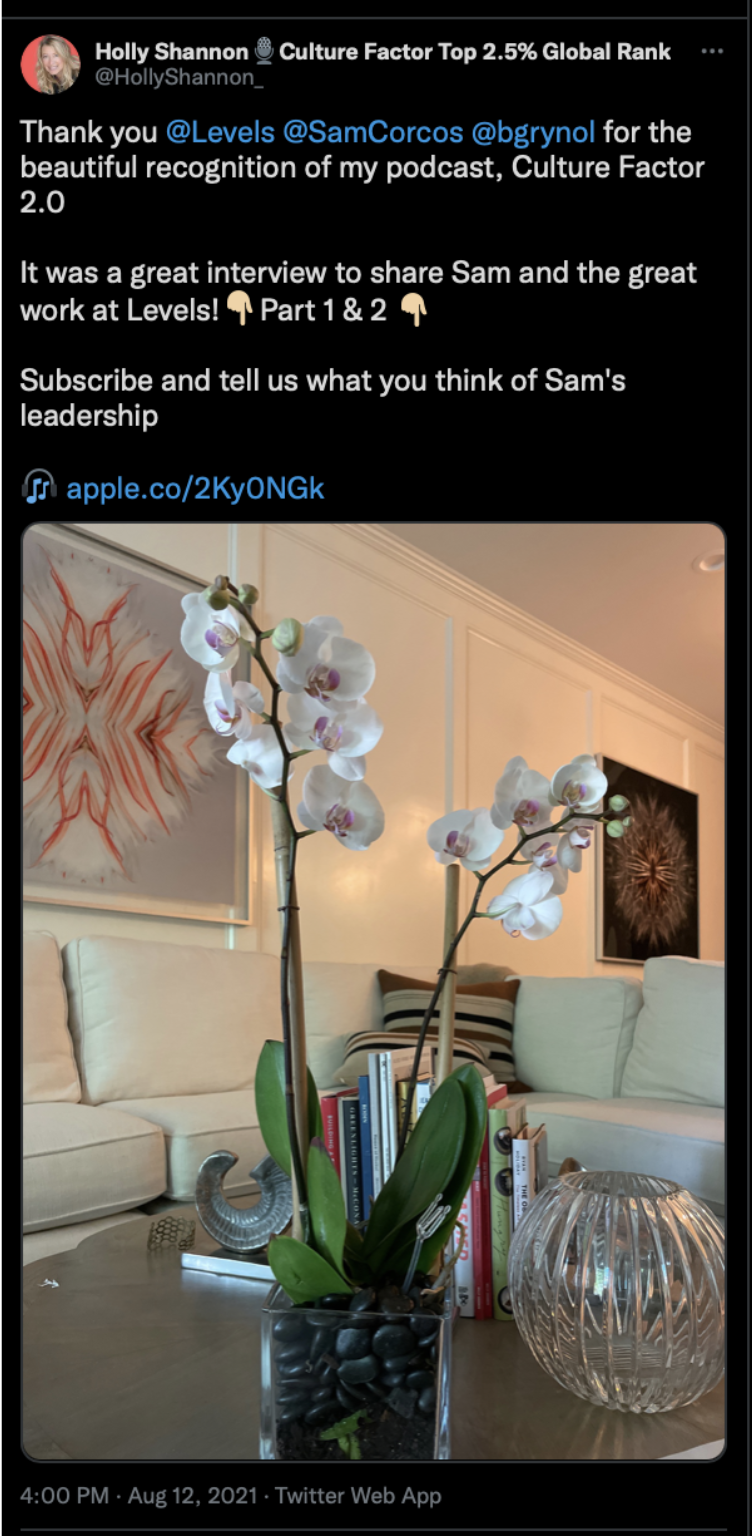
Additionally, content creators and personalities who create podcasts often have other platforms that you can eventually tap into as well. We’re now talking to some of the hosts from our first tour about affiliate partnerships, YouTube features, paid placements, and so much more — making podcasting just the start of a powerful go-to-market strategy.
And of course, be sure to close the loop with the person who made the initial intro — this can’t be overstated. If someone has helped you and made an introduction, follow up with that person to let them know how things panned out. For us, once we recorded the show, we would send a thoughtful email to the person who initially made the intro, updating them and thanking them. Anecdotally, people are extremely pleasantly surprised when loops get closed, and they’re way more likely to make introductions for you in the future. You have proven to them that not only do you appreciate their support, but that you handle relationships with diligence, thoughtfulness, and attention to detail.
The key to not dropping this ball is setting email reminders. If you don’t use an email provider or tool that allows this, you need to start ASAP (we use Superhuman). In addition to email reminders, I set a recurring Google calendar event called “Close loop with people who made intros” where I do a lookback on my week and ensure nothing has fallen through the cracks.
OUR RESULTS: 100 SHOWS IN SIX MONTHS.
We secured more than 100 founder interviews in six months (at the end of six months, about 70 had been released and another 30 were in the pipeline as scheduled or recorded).
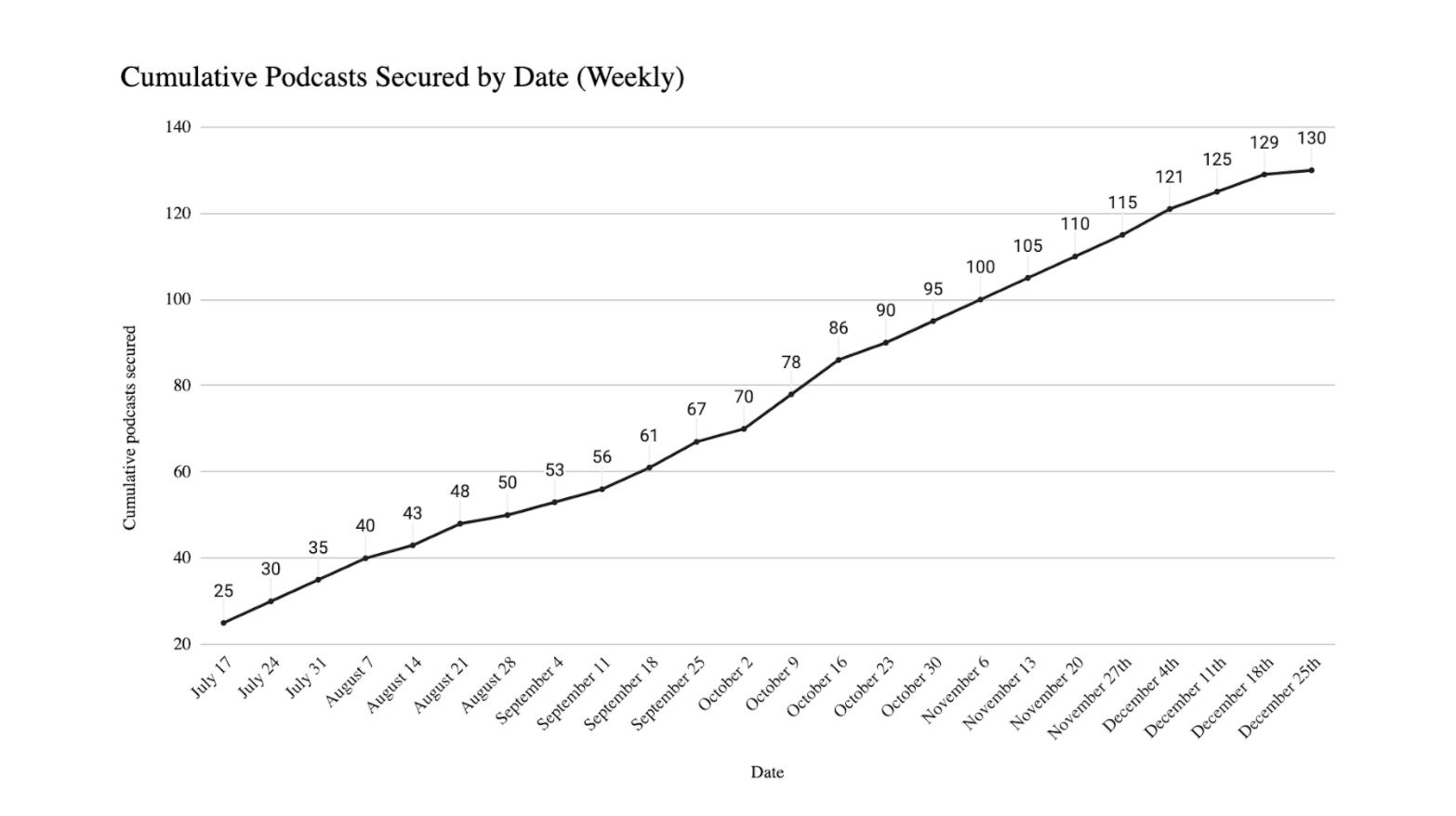
These shows led to well over a million people spending, on average, an hour learning about why we started our company and the problem we’re solving: the metabolic health crisis. It’s hard to overstate what this did for our business in our early days of operation. During this stretch, our website traffic more than doubled from an average of around 18,000 users a month to more than 40,000.
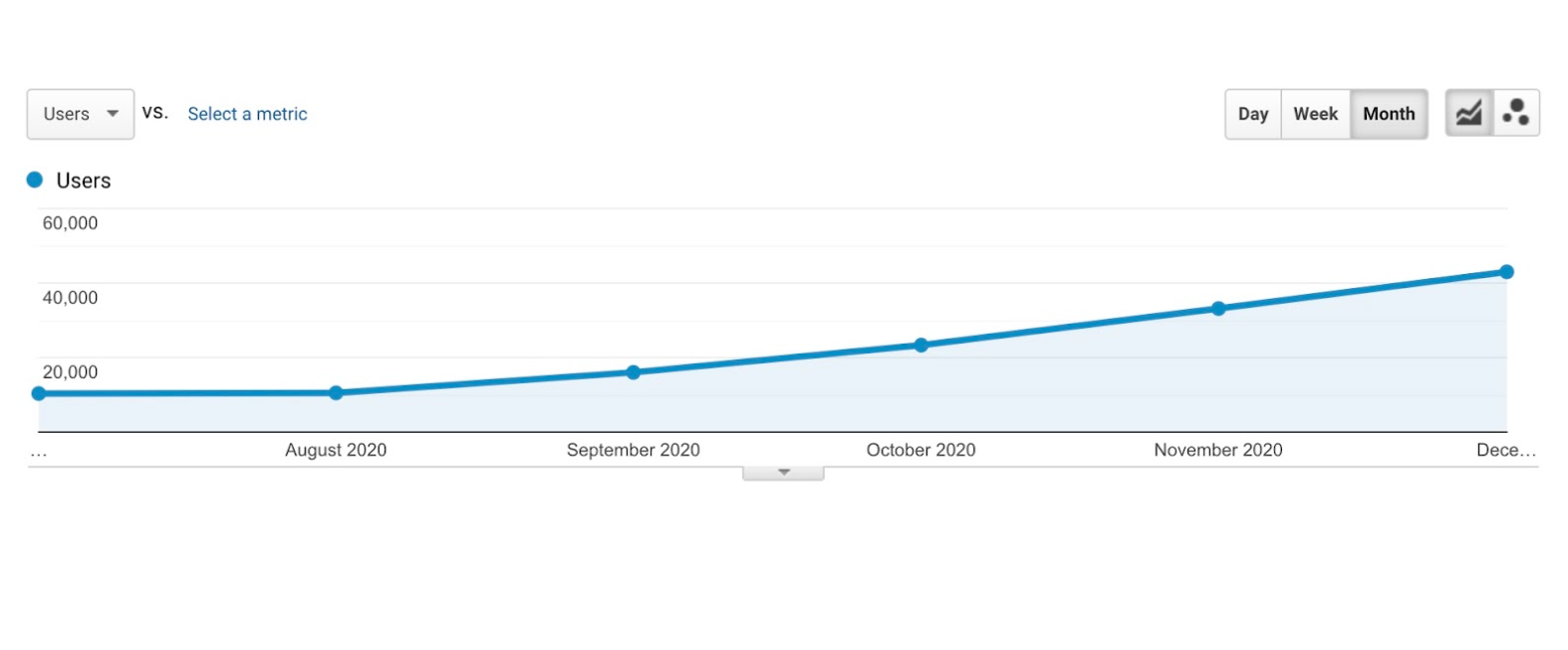
This effort also helped grow our waitlist from 16,000 to 67,000. It’s important to note that our podcast push was happening alongside many other efforts like building our in-house content engine, each of which contributed to growth in website traffic and waitlist signups.
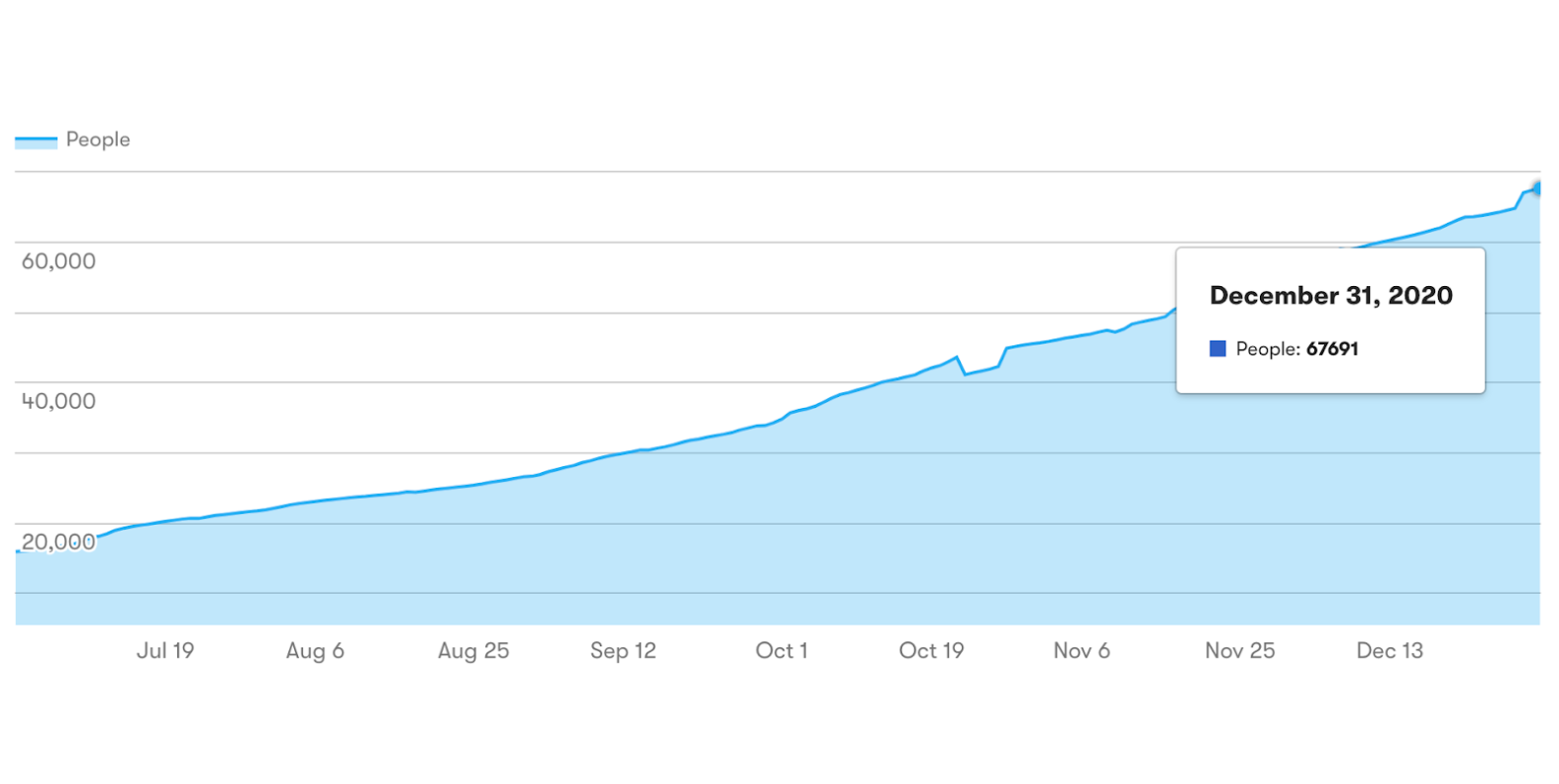
There have also been countless intangible benefits: It’s been the backbone of our networking efforts and led to literally hundreds of additional introductions in the health and wellness industry, including significant opportunities across sales and marketing, PR, hiring and investing (some of the podcast hosts themselves are even angel investors). Anecdotally, we also hear constantly from our community that they first heard about us through their favorite podcast.
RESOURCING: WHAT DOES IT TAKE TO EXECUTE A PODCAST TOUR?
Should everyone do a podcast tour? How much time and energy does this take? These are important questions. When I joined Levels as the third full-time employee and started managing this effort, I was spending about 50% of my time on this project for the first couple of months. Once the engine was running, this came down to about 25% of my time. My primary responsibilities were:
- Managing all email outreach, introductions, and scheduling (done mostly through Calendly links).
- Creating and refining pitches, blurbs, and email snippets to be used in outreach and email correspondence.
- Managing relationships with podcast hosts, who often wanted to try our product before an interview, or had follow-up questions about the company.
- Maintaining and updating our lead list and reporting out on progress to the team.
- Listening to almost all episodes to provide feedback to our founders (with the help of other team members).
- Closing the loop with podcast hosts (thanking them and sending flowers), as well as the people who made introductions.
- Making introductions for others in your network (investors, advisors, other friends who are founders, etc.).
Needless to say, it’s difficult for a company founder/spokesperson to execute this well without someone on the team as a dedicated project manager. You should be prepared to resource this project with 50% of one full-time employee's bandwidth. In addition to the project manager, this also requires a significant investment of the founder(s) who will be doing the interviews:
- For your first 10-20 shows budget roughly 3 hours per podcast interview: 1.5 hours of prep time, 1 hour of interview recording, 30 minutes of follow-up with the host.
- For all shows after your first 10-20 budget 2 hours per podcast interview: 30 minutes of prep, 1 hour for interview recording, 30 minutes of follow-up with the host.
We’re also fortunate that Levels has five founders to share these duties. If your company has one founder and CEO, the opportunity cost of this project is greater, and you may be skeptical of pursuing it. I would still encourage most companies to experiment with podcast interviews, even if you can’t pursue it to the extent that we did.
If you’re in this camp, it’s also worth exploring having a non-founder spokesperson do some of these interviews – this can be another executive at the company or an advisor. Some companies even hire a public-facing “educator” or spokesperson to lead podcasts and press appearances.
WRAPPING UP: EXPANDING YOUR PODCAST FOOTPRINT.
There are a number of additional ways to integrate podcasts into your marketing strategy: the most common is podcast advertising, followed by launching your own show. Both strategies have their pros and cons and depend on your goals as a company.
When it comes to starting your own branded podcast (think, Rework by Basecamp or The WHOOP Podcast), you own the channel, which means it can serve as a far more powerful long-term sales and marketing funnel. The downside is that it’s time-consuming and expensive to create your own show, and it often takes years to build an audience that’s a meaningful size. Most companies start podcasts and quit the effort after 5-10 episodes – according to one report, 64% of all podcasts have fewer than 10 episodes.
As for podcast advertising, it’s the fastest way to scale up leveraging the podcast platform, whether your goals are brand awareness or generating revenue. Ads are, however, increasingly pricey and increasingly skipped over, so you may need to be comfortable with not seeing your desired ROAS (return on ad spend). Additionally, they’re short, so if your product requires longer education time or the audience is not already familiar with the product category, results may be disappointing to start. That said, advertising will no doubt be a part of our strategy as we shift from focusing on awareness to growth.
For us, the next 6 months will be focused on building off the podcast tour in the following ways:
- Developing deeper partnerships with top podcasters and activating their other platforms, including in a paid sponsorship capacity — for example, collaborating on blogs, social promotions and newsletters.
- Ramp up podcast advertising. As we prepare to ramp up our growth, we will be doing more podcast advertising tests to better understand our marketing funnel, customer acquisition costs, and in what communities our product resonates the most.
- Grow our own podcast. We recently launched our own show, giving the world an inside look into how we’re building Levels.
Cover image by Getty Images / akinbostanci
